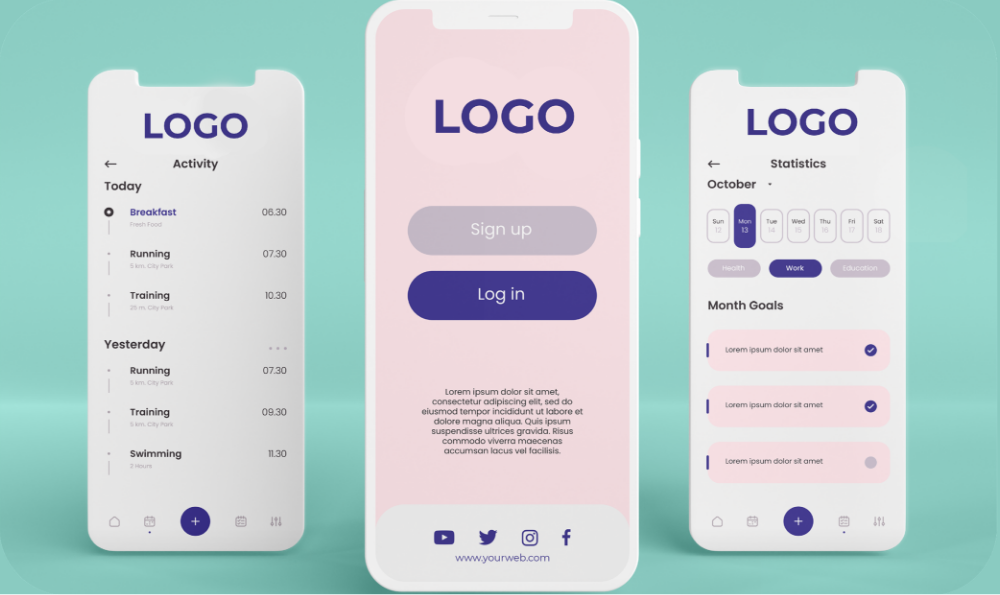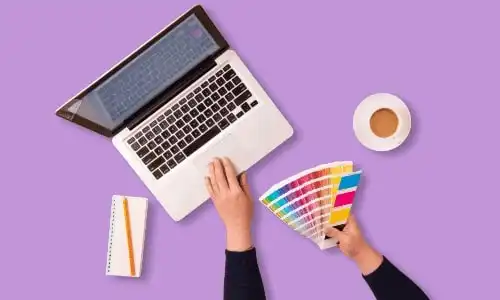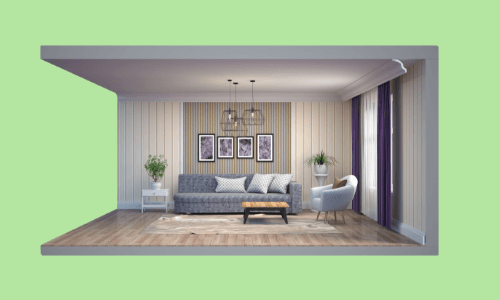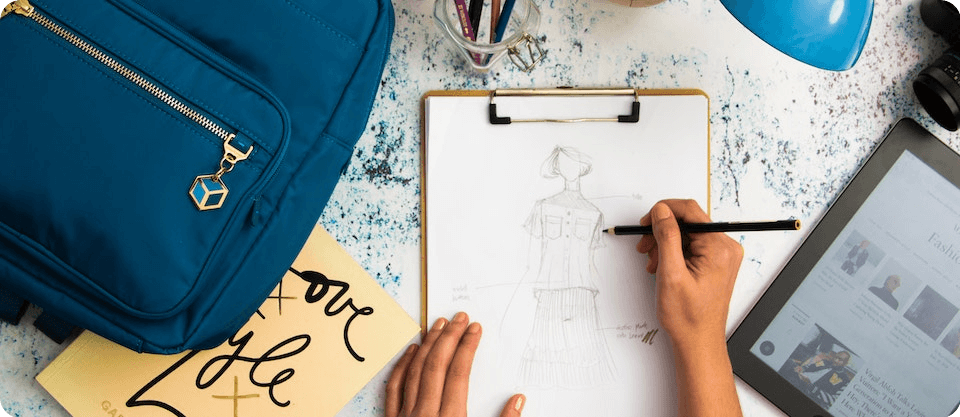
How to improve your drawing skills to be become a fashion designer
What is fashion design?
Fashion design is a form of art dedicated to the creation of clothing and other lifestyle accessories. Modern fashion design is divided into two basic categories: haute couture and ready-to-wear.
The haute couture collection is dedicated to certain customers and is custom sized to fit these customers exactly. In order to qualify as an haute couture house, a designer has to be part of the Syndical Chamber for Haute Couture and show a new collection twice a year presenting a minimum of 35 different outfits each time.
Ready-to-wear collections are standard sized, not custom made, so they are more suitable for large production runs. They are also split into two categories: designer/createur and confection collections. Designer collections have a higher quality and finish as well as a unique design. They often represent a certain philosophy and are created to make a statement rather than for sale. Both ready-to-wear and haute-couture collections are presented on international catwalks.
How to get into fashion design
Earning a fashion design degree can help designers launch their careers. But a degree alone does not guarantee success. Fashion designers also need a strong portfolio, work experience, and a professional network to break into the fashion industry. Career success also depends on skill. Designers must know their brand identity, aesthetic, and niche in the industry.
Successful fashion designers work their way up. Many start building skills long before entering a fashion program. Learning how to sew, following fashion trends, and practicing with design software all help future designers gain admission to competitive fashion programs. After earning a degree, designers often work as stylists, fashion buyers, and assistants to established designers. These roles help designers expand their skills and build a network. Learn more about the various roles and career opportunities in fashion design.
1. Complete a fashion design program
Most fashion designers hold an art and design bachelor’s degree. During a fashion design program, students study fabrics, fashion theory, and colour theory. They also learn how to create styles using computer-aided design (CAD) software. Fashion design courses use project-based assignments to help students strengthen their skills and build their portfolios.
Fashion design degree programs incorporate coursework in fashion merchandising, business, and marketing. Designers draw on these skills to launch a line, evaluate customer demand for styles, and earn a profit. At the conclusion of a fashion design program, seniors may design a line for a school fashion show.
2. Gain hands-on experience
A fashion design or fashion merchandising degree provides valuable training for a career in fashion. However, designers also need hands-on experience.
During school, fashion designers should pursue internship opportunities. Many colleges connect aspiring designers with companies hiring interns. During an internship, students work under the supervision of an experienced fashion designer. Internships provide practical experience with the business side of the fashion industry. While students hone techniques and aesthetics in class, an internship provides career training.
In addition to internship experience, students should consider part-time or contract work opportunities. Working for a small brand helps students build their portfolio and potentially launch their own line. Experience with a major brand helps designers build their resume and make valuable connections in the industry.
3. Network within the industry
Like other artistic fields, networking helps fashion designers find professional opportunities, secure clients, and advance their careers. Designers should begin networking as early as possible, even before entering a fashion program. Networking events in school offer a valuable resource for meeting fashion professionals.
Connect with other designers, suppliers, buyers, and everyone else in the industry. Those connections can pay off once you begin freelancing or applying to full-time positions.
4. Build your design portfolio
Careers in fashion require a strong design portfolio. Many fashion designers start building their portfolios before entering fashion programs. Students expand their portfolios to showcase their designs and skills. For example, designers might want to show range in their portfolio by including ready-to-wear looks and custom high fashion looks, or they may emphasise their technical skills.
Throughout a fashion career, designers update their portfolios. Internships, entry-level jobs, and stylist positions all help designers add to their portfolio.
5. Stay up-to-date on the fashion industry
Fashion designers need to stay on top of trends and keep up with fashion news. In an industry that changes seasonally, designers must devote time to following fashion cycles.
Several resources help fashion designers stay current. Professional associations, fashion magazines, and fashion shows showcase trends and industry information. Following other fashion designers and watching red carpet events also helps designers keep up with trends. Designers can then incorporate new styles into their upcoming projects.
Fashion sketching for beginners
In the world of fashion, designers believe in bringing their ideas to life with the help of drawings. A fashion sketch is the first step towards creating beautifully designed garments. Fashion Design Drawings play a vital role in the designing and apparel-making industries. Designers use these drawings to communicate with other people about their ideas. These drawings function as an initial sketch which is later finalised by comparing different colours and patterns.
Some types of these drawings are:
1. Flat sketch or fashion flat
Flat sketches are also known as technical flats in the world of fashion. These sketches are linear 2-dimensional black and white illustrations of garments. This type of sketch looks as though the garment is laying flat on a surface for display of its designs, stitching, and other detailing. These types of sketches are usually made using software programs.
2. Tech sketch
Tech sketch is a flat sketch with details of the particular specifications of the garment in written text. These sketches are also known as callouts. Fashion designers or fashion illustrators mostly use tech sketches to represent a design more precisely with detailed explanations.
3. Spec
Spec or specification is a type of fashion design drawing which is usually used for the manufacturing of apparel. These drawings include a lot of detailing of the garment like the type of fabrics used, the estimated cost of production, etc.
4. Working drawing
Pattern makers use these types of fashion drawings. These drawings contain all the specifications needed by the pattern maker to make the pattern pieces like the fabric swatches and fasteners used.
5. Presentation drawing
Presentation drawing is the final sketch of the garment which a fashion designer presents to the client or the senior designers.
6. Fashion croquis
Fashion croquis is the drawing of the figure of the apparel that can function as a template over which one can design the garment by tracing easily.
Drawing skills and techniques
A good fashion illustrator not only draws a piece of clothing, but also interprets it in their own way and is able to convey a certain mood behind a designer’s collection.
Fashion drawing is a skill, and can be learned or improved using a lot of techniques. Here are some useful techniques for you to improve your fashion drawing skills:
1. Understand anatomy
To be good at fashion drawing it is vital to know how to draw anatomically correct proportions of a figure. A correct drawn figure allows the garment to look appealing on it. It will be easier for you to draw certain posed figures if you know how to draw them correctly.
2. Use technology
Nowadays, with several advanced technologies in the market, every field is growing at a super-fast pace. In the fashion industry there is a lot of software that can help you in beautifying your designs and illustrations. For example, a background of a lane or runway can be added while representing a design to the clients. This can give more clarity to the design idea like where it can be worn.
3. Make patterns
Patterns can also tell a story on their own. They can make a simple fabric very interesting. Patterns are never going out of fashion. To design various beautiful fashion drawings, try to add some touch of appealing patterns to it.
4. Hairstyles matter too
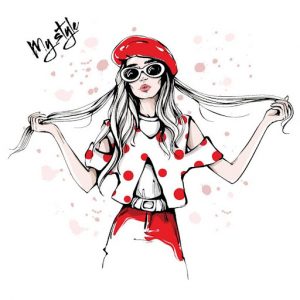
With the figure shape and dress design, the hair of the figure also matters a lot. Learn how to illustrate different hairstyles based on hair textures and thickness. A figure can look classier if an ideal hairstyle is illustrated with it.
5. Focus on the accessories too
In the fashion world, not even a small detail is left out. Accessories also play a vital role in a figure representation of a garment. Choose the accessories wisely. The final look of your drawing should tell a story. Design it carefully and beautifully.
What do you need for fashion drawing?
If you would like to try your hand at building your own croquis, or fashion figure template, here is what you will need:
- An 8.5×11 inch paper
- A hard pencil
- A ruler
- An eraser
How to draw a fashion figure
The body proportions of a fashion figure are not proportional to the human body. Generally, a fashion figure follows the industry standard of the ‘nine head’ length: this means the length of a fashion figure is approximately nine times the size of the drawing’s head. These elongated fashion figures help to showcase garments, particularly dresses and skirts.
Here is a step-by-step guide to completing a fashion drawing:
- Draw a vertical line down the center of the paper. This line, which stretches from the head to the feet, will be the fashion figure’s center of balance.
- Separate the paper into nine equal sections. The nine sections will include the fashion figure’s head, bust, waist, hips, thigh, calves, ankles, and feet. You can draw horizontal lines, approximately an inch and one-eighth each, to separate the nine sections.
- Draw the pelvic area. In the middle of the balance line, draw a square for the fashion figure’s pelvis. This can be angled in different directions to create different poses.
- Draw the torso and shoulders. Draw two lines upward from the top of the pelvic square to create the torso. The lines curve inward and outward again to create the waist. The shoulders should be approximately the same width as the pelvis, but the shoulder lines can be angled to create a pose that is rounded forward.
- Draw the neck and head. The neck should be one-third of the shoulder width, and half the length of the head. Draw a circle for the head in proportion to the body.
- Draw the legs. The figure’s legs should be approximately four times the length of the head drawn. The legs are portioned into two sections: the thighs and the calves. The top of the thighs should span the same length as the head. Taper the line down to the knee, and again to the ankle so that the ankles are approximately one fourth the size of the head.
- Draw the arms. Create the arms with tapered lines to the elbow and then again to the wrist. The arms can be positioned alongside the figure’s body or posed on the hips. Finish with the hands and fingers.
- Draw the feet. The feet should be approximately the length of the head.
- Create your fashion design. Now that the fashion figure is sketched, you can begin to build your design creations on top of the figure.
- Illustrate your design. Shade the design to show the movement of the fabric or to highlight where material gathers on the garment. Colour in the fashion drawing to add dimension. Add embellishments to the fabric to demonstrate your own style. Add facial details, a hairstyle and accessories to complete the look.
Examples of fashion design drawings
Here are some examples for your reference. When we need a reference what’s better than the best? Here we have some amazing fashion designs by some of the best fashion designers.
Christian Dior
Christian Dior does not need any introduction. He is no doubt one of the best fashion designers in the world. Dior is famous for designing dresses with flared-up waists. Take a look at this design by him.
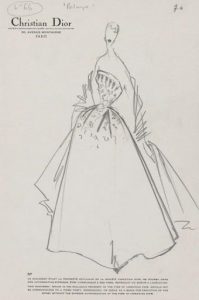
Christian Bérard
Famous for his unique fashion model drawings Christian Bérard is no doubt one of the best designers the fashion world has seen. His designs illuminate simplicity. One of the features of his fashion drawings is that he uses watercolours and curves in them. Curious? Have a look at one of his masterpieces.
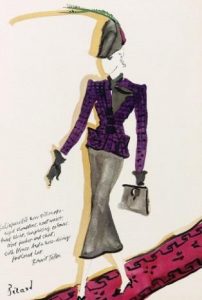
Monique Lhuillier
Monique Lhuillier is a fashion designer famous for her red carpet gowns. Her designs are eye-catching and alluring. Her drawings usually show shadows and three-dimensional detailing. Here is a fashion drawing by her.
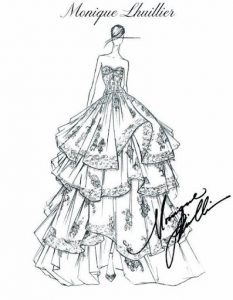
Elie Saab
Elie Saab is famous for his evening gowns and bridal wear. His designs are a fusion of western and eastern cultures. His sketches usually have gradients to show the volume of the fabric. Here is a design by him.
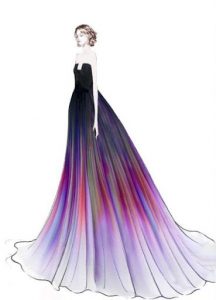
Givenchy
Givenchy is a French fashion house, where world-renowned designers like John Galliano work. This fashion house has introduced a lot of iconic designs and trends to the world. Here is a design by Givenchy.
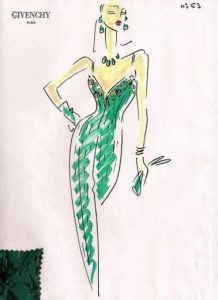
Skills required for becoming a fashion designer
Fashion careers require a variety of skills. Designers draw on their creativity and artistic sensibilities to create designs. The career demands effective communication skills, an ability to collaborate, and a detail-oriented outlook. Hard skills like the ability to use design software, clothing construction training, and a deep knowledge of textiles and colour also help designers.
Students planning to run their own fashion business also need strong marketing, sales, advertising, and management skills. Self-employed designers draw on sales and product development skills to understand their consumers and create in-demand designs. Overall, fashion designers must balance their passion and creativity with technical and business know-how.
As a fashion designer, the skills below are essential to gaining success in the industry:
1. Artistic ability and creativity
The most important skill for a fashion designer or any artist is a natural talent. You want your art to be recognisable and distinguishable. Many fashion designers had careers as architects, graphic designers, or in other related fields before switching to fashion. Many artistic skills are innate and can’t be taught—however, formal classes and daily practice can help you enhance your skill set.
2. Communication skills
Any top fashion designer needs effective communication skills to develop their brand. Throughout your career, you may have the opportunity to be a part of a design team or lead one of your own. When working with teams, bring your research and ideas to the table instead of waiting for direction. Listening is a large part of collaborating effectively. You aren’t building a collection alone. You have to hear what your teammates are saying in order to provide feedback and push your designs to evolve.
3. Sewing and drawing skills
Sewing is a fundamental skill for any fashion designer. Complete proficiency in basic skills of fashion construction—such as navigating a sewing machine—isn’t necessary, but it would greatly benefit any budding designer to develop an intimate knowledge of the craft involved in producing your designs. Knowing about different fabrics and the properties that make them unique will help you better select the right material for your garments.
4. Understanding of fabrics and materials
You can familiarise yourself with the various elements of garment design by touching fabrics, changing the tension of different stitches, and experimenting with embroidery. Take advantage of resources such as technical classes, online tutorials, and craft books that walk you step by step through the construction of a garment. Selecting fabric is an important part of expressing your ideas. Touch and feel the fabrics you intend to work with; making creative decisions based on only a swatch may limit your ability to understand movement and draping on a human body.
5. Fashion degrees (or lack thereof)
Many fashion schools and degree programs in the United States, like Parsons School of Design or Fashion Institute of Technology, have launched the careers of successful designers, like Marc Jacobs. These programs give you the tools and training to thrive in the business. However, you don’t need a bachelor’s degree in fashion design to become a top designer. Successful fashion designers without traditional design school degrees include Diane von Furstenberg, Karl Lagerfeld, Michael Kors, Jean Paul Gaultier, Alexander Wang, and Donna Karan.
Here are some additional tips to get you on your way to becoming a top designer.
Fashion designing tips
The career path to becoming a fashion designer doesn’t happen overnight. Though it can take years to break into the business, the following tips will help you get started:
1. Get inspired
Pull inspiration from things you are genuinely interested in: music, art, history, architecture, and especially people. With inspiration flowing, use mood boards to organise and edit your thoughts. Your boards can consist of a wide range of visual references, including editorial sources, street style, and photographs (even if they aren’t related to fashion). You can also compile fabrics, textures, colours, style references, and accessories.
2. Study fashion trends
While you don’t need a fashion degree to design clothes, it helps to have a fundamental knowledge of art, creation, and the fashion business to get you started as a clothing designer. Take sewing or pattern-making classes if you don’t know how to physically create garments, or take a drawing class if you’re unfamiliar with sketching or computer-aided design. Even classes in fashion history can contribute to your design inspiration. Familiarise yourself with the latest fashion trends by studying current fashion shows and magazines.
3. Start smart, not small
Your goal at the beginning of your career is to gain as much experience as you can. Ask questions, reach out to collaborators, and seek out mentors. Look for internships or entry-level positions to get closer to the products you want to create and the customers you hope to serve. If you surround yourself with people who share your excitement and drive, you will push each other to create better products. And most people want to be around others who are excited about what they’re doing.
4. Sketch your ideas
The first goal of a sketch is to begin visualising the design in your head. The second goal of a sketch is to create a blueprint for the patternmaker to create your first muslin or prototype. These minimalistic, flat drawings will communicate the technical elements of your idea, including darts and seams, sleeve length, overall length, fit, shape, and more. You can indicate what fabrics might be used for each garment by attaching a swatch to the page. This gives the patternmaker an idea of the weight or stiffness the garment should have, and whether they are printed, patterned, or solid.
5. Hone your voice and signature style
You don’t have to stay within a particular style, as long as you make thoughtful creative decisions that aid your brand as a designer. All of your creative decisions in the design process—even the details—tell a story.
6. Build your collection
Creating a collection is not a linear journey. You can build a unified collection that presents a singular idea, or your collection can be composed of a variety of looks representing different ideas all connected by your design choices. These might be consistent proportions, colours, or even the lack of colour. You can allow for eclecticism and diversity within the spirit of your collection. Focus your collection to display your point of view. If you choose to limit the colours in your collection, you ought to vary your silhouettes, and vice versa. You can ask your partners, peers, or friends to give their feedback on your designs and how the pieces all fit together.
Conclusion
Fashion design drawings, as you can see, introduces a person to the idea of what an outfit actually looks like, once executed on paper. These drawings are essential to present your ideas to the world. If you are a budding fashion designer, take time to understand the value of possessing drawing skills in the fashion world.
Get your foot in the fashion design door by starting our Fashion Design Course.
